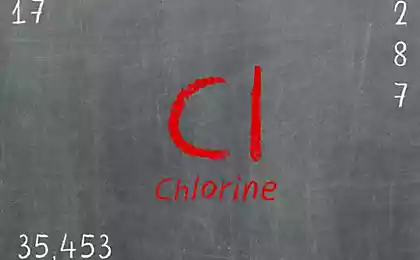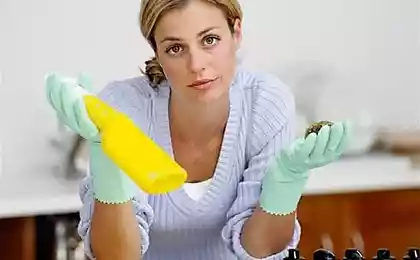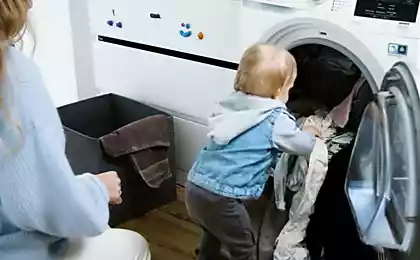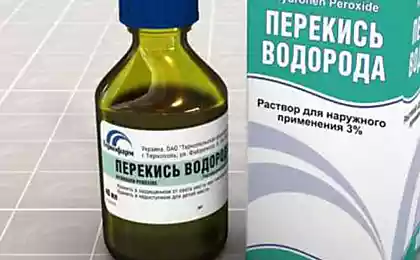476
Chlorine bleach not only
Should I be concerned about the presence of chlorine in cleaning products and detergents that we use at home? The answer is simple — Yes! No matter whether chlorine alone or mixed with other chemicals, detergents containing it, is detrimental to health.

Especially pay attention to the following:
— detergents used in dishwashers,
— bleach,
— disinfectants
— anti-mold
— cleaning of toilets.
In order not to specify that cleaning products contain chlorine, they write that it is composed of sodium hypochlorite (sodium hypochlorite) or simply hypochlorite (hypochlorite). Evaporation contained in the cleaning agents with high chlorine content can cause irritation to the lungs, which is especially dangerous for people with heart problems or suffering from respiratory diseases, such as asthma or emphysema.The risk increases if detergents with chlorine are used in small, poorly ventilated rooms such as bathrooms.
Chlorine is also a very caustic substance that can damage the skin and eyes. In 1990 in the U.S., the clean air Act, chlorine was added to the list of hazardous air pollutants, as well as, the exposure of chlorine in the workplace is regulated by Federal law. The use of detergents that contain chlorine in the dishwasher and washing machines, can contaminate the air in your home. The water in the machine, which contains chlorine from the detergents transfers it to the air through evaporation process. And then, we breathe polluted air.Dishwashers are the greatest polluters, releasing chemicals into the air, in the form of a vapor mist when you open the door of the machine. In washing machines chlorine mixes with the dirt from the clothes and produces toxic chlorine-containing organic chemicals.
Chlorine is dangerous even when storing it at home. In 1993, the U.S. centers for the control of poisoning were reported 40,000 cases of poisoning with chlorine in the home, much more than any other chemical element. Especially dangerous drugs with perfume perfume, chlorine and products with chlorine bleach plus a surfactant. Clogging smell of chlorine with aromatic substances (in fact, it turns out that chlorine-containing drugs nice to breathe) can lead to chlorine poisoning. Another danger lies in the mixing of products containing chlorine, intentionally or accidentally. These mixtures can produce chlorine gas and chloramines are toxic gases, highly damaging lung tissue.
Chlorine
Other names hypochlorite (hypochlorite), sodium hypochlorite (sodium hypochlorite), sodium dichloroisocyanurate (sodium dichloroisocyanurate), hydrogen chloride (hydrogen chloride), hydrochloric acid (hydrochloric acid). Chlorine began to be manufactured in the early 20th century. It was used as a poison during the First World war.
Chlorine ranks first in the U.S. among the chemicals that poisoned people in the workplace and at home. Chlorine is a very toxic substance that is produced using energy-costly process of electrolysis of sea water. In this production process also produces very toxic by-products.
Sodium hypochlorite (known as bleach is 5% solution of sodium hypochlorite) is a chemical precursor to chlorine and to treat them accordingly, because any use creates pure chlorine in the environment.
Besides the fact that chlorine is a very poisonous for living organisms, it reacts with organic materials in the environment and produces other hazardous and carcinogenic toxins, including trihalomethanes (trihalomethanes (THMs)), chloroform and organochlorine (organochlorines), a very dangerous class of components that cause disruption of the endocrine and immune systems. The most well-known organochlorine — DIOXIN.
Products containing chlorine (or any of their derivatives, or chemical precursors, including sodium hypochlorite) should be considered as extremely dangerous and unacceptable to use.Also, any other chemicals that contains in its name "-chloro -" or known as "bleach", also use harmful, as they contain highly toxic and harmful to the environment chlorine component. Chlorine and chlorine components are also one of the reasons for the disappearance of atmospheric ozone. The chlorine used in the wash, it damages both natural and synthetic fabrics.
Dioxin
Waste from paper mills discharged into the environment after the bleaching of paper with chlorine, contain dioxins, which do not decompose, which means that, over time, they accumulate in air, water and soil. As soon as they get there, they come in our food, we poison the food we eat. Dioxins, in our time, so widespread in the environment that they are in the body of almost every man, woman and child. Every American daily swallowing their 300 to 600 times more so-called "safe" dose. They accumulate in the body to a critical level, and then, their impact begins to emerge.
Dioxins — lethal. They are the most carcinogenic chemicals known to science. According to the office for the protection of the United States environmental protection Agency (EPA), dioxins are 300 000 times more stronger carcinogen than DDT, which was banned in USA in 1972. It is impossible to cover up or sugarcoat the devastating effect of dioxins on humans and the environment. Recent studies have confirmed that dioxins cause cancer, destruction of the reproductive function in adults, deformities and problematic development of children and the collapse of the immune system.Dioxins can cause these irregularities in amounts in the hundreds of thousands of times lower than most hazardous chemicals.
Organochlorine
Like dioxins, organochlorine — long-lived substances, easily propagated in the surrounding space. Now, every person on the planet has in its body these substances. Scientists are very concerned about these chemicals because they believe that when the molecules of organochlorine enter the body, they mimic hormones which are a natural substance produced by our body in small amounts to regulate many of its functions. Since the molecules of organochlorine have the same shape as the molecules of hormones, they can enter the cells and the results of this penetration is just horrible.
This lowering of IQ, reduced ability to reproduce offspring, deformities of the genitals, breast cancer, prostate cancer, testicular cancer, deterioration in sperm abnormalities of the immune system through a process called endocrine system disruption.
Studies have shown that dioxins and organochlorine cause birth defects, cancer, reproductive defects and defects in development. Many scientists believe that the recent reports about the decrease in the number of sperm in men living in industrialized countries, caused by organochlorines. Similar problems arise in animals due to environmental pollution with these substances. Many biologists believe that organochlorine responsible for the unusual mutations, sterility, immune system disorders, and the disappearance of animal species in the territory from the Great Lakes to the North sea.
What you can do to protect themselves from the effects of chlorine.
1. Buy unbleached paper products (napkins, toilet paper, kitchen paper towels, etc.).Because whitewashing paper can contain dioxin and organochlorine that can go in any food or to any person in contact with them.
2. The office for the protection of the United States environmental protection Agency (EPA) warns that the result of the use of bleached paper filters for coffee makers can be a lifetime of poisoning by dioxin that "exceeds acceptable norms". Buy unbleached filters.
3. Using detergents that contain chlorine in the dishwasher or washing machines, you pollute the air in your home.
The water in the machine, which contains chlorine from the detergents transfers the chlorine into the air through evaporation process. Choose foods that do not contain chlorine.
Recipes for non-toxic disinfectants
You know where the hotbed of germs in your bathroom. Not where you think, and in the sewer. What can be done about this? Research medical center tufts New England showed that disinfectants, first, is not effective, and, secondly, lead to the emergence of more resistant types of bacteria. However, there is a great non-toxic way to get rid of bacteria in the bathroom or any other place.
1. Pour a Cup or two of vinegar into the drain pipe. Vinegar — 80-99% destroys bacteria and viruses. Do this 1-2 times a week.
2. Prepare an antibacterial spray for toilet seats, lids, door handles, switches, cutting boards, etc. (anywhere where bacteria can grow).
Lavender has a more pronounced antiseptic than phenol, which is used for the production of antibacterial agents.
Ingredients
1 Cup water; 1 teaspoon of lavender oil; 10-15 grams of alcohol to dissolve the oil.
Pour alcohol in a spray bottle, add the oil, shake the bottle, pour water. Spray the surface, leave for 15 minutes, then rinse, but do not rinse.
Shelf life is unlimited.published
P. S. And remember, only by changing their consumption — together we change the world! ©
Source: ruslekar.info/Hlor--ne-tolko-otbelivatel-2774.html

Especially pay attention to the following:
— detergents used in dishwashers,
— bleach,
— disinfectants
— anti-mold
— cleaning of toilets.
In order not to specify that cleaning products contain chlorine, they write that it is composed of sodium hypochlorite (sodium hypochlorite) or simply hypochlorite (hypochlorite). Evaporation contained in the cleaning agents with high chlorine content can cause irritation to the lungs, which is especially dangerous for people with heart problems or suffering from respiratory diseases, such as asthma or emphysema.The risk increases if detergents with chlorine are used in small, poorly ventilated rooms such as bathrooms.
Chlorine is also a very caustic substance that can damage the skin and eyes. In 1990 in the U.S., the clean air Act, chlorine was added to the list of hazardous air pollutants, as well as, the exposure of chlorine in the workplace is regulated by Federal law. The use of detergents that contain chlorine in the dishwasher and washing machines, can contaminate the air in your home. The water in the machine, which contains chlorine from the detergents transfers it to the air through evaporation process. And then, we breathe polluted air.Dishwashers are the greatest polluters, releasing chemicals into the air, in the form of a vapor mist when you open the door of the machine. In washing machines chlorine mixes with the dirt from the clothes and produces toxic chlorine-containing organic chemicals.
Chlorine is dangerous even when storing it at home. In 1993, the U.S. centers for the control of poisoning were reported 40,000 cases of poisoning with chlorine in the home, much more than any other chemical element. Especially dangerous drugs with perfume perfume, chlorine and products with chlorine bleach plus a surfactant. Clogging smell of chlorine with aromatic substances (in fact, it turns out that chlorine-containing drugs nice to breathe) can lead to chlorine poisoning. Another danger lies in the mixing of products containing chlorine, intentionally or accidentally. These mixtures can produce chlorine gas and chloramines are toxic gases, highly damaging lung tissue.
Chlorine
Other names hypochlorite (hypochlorite), sodium hypochlorite (sodium hypochlorite), sodium dichloroisocyanurate (sodium dichloroisocyanurate), hydrogen chloride (hydrogen chloride), hydrochloric acid (hydrochloric acid). Chlorine began to be manufactured in the early 20th century. It was used as a poison during the First World war.
Chlorine ranks first in the U.S. among the chemicals that poisoned people in the workplace and at home. Chlorine is a very toxic substance that is produced using energy-costly process of electrolysis of sea water. In this production process also produces very toxic by-products.
Sodium hypochlorite (known as bleach is 5% solution of sodium hypochlorite) is a chemical precursor to chlorine and to treat them accordingly, because any use creates pure chlorine in the environment.
Besides the fact that chlorine is a very poisonous for living organisms, it reacts with organic materials in the environment and produces other hazardous and carcinogenic toxins, including trihalomethanes (trihalomethanes (THMs)), chloroform and organochlorine (organochlorines), a very dangerous class of components that cause disruption of the endocrine and immune systems. The most well-known organochlorine — DIOXIN.
Products containing chlorine (or any of their derivatives, or chemical precursors, including sodium hypochlorite) should be considered as extremely dangerous and unacceptable to use.Also, any other chemicals that contains in its name "-chloro -" or known as "bleach", also use harmful, as they contain highly toxic and harmful to the environment chlorine component. Chlorine and chlorine components are also one of the reasons for the disappearance of atmospheric ozone. The chlorine used in the wash, it damages both natural and synthetic fabrics.
Dioxin
Waste from paper mills discharged into the environment after the bleaching of paper with chlorine, contain dioxins, which do not decompose, which means that, over time, they accumulate in air, water and soil. As soon as they get there, they come in our food, we poison the food we eat. Dioxins, in our time, so widespread in the environment that they are in the body of almost every man, woman and child. Every American daily swallowing their 300 to 600 times more so-called "safe" dose. They accumulate in the body to a critical level, and then, their impact begins to emerge.
Dioxins — lethal. They are the most carcinogenic chemicals known to science. According to the office for the protection of the United States environmental protection Agency (EPA), dioxins are 300 000 times more stronger carcinogen than DDT, which was banned in USA in 1972. It is impossible to cover up or sugarcoat the devastating effect of dioxins on humans and the environment. Recent studies have confirmed that dioxins cause cancer, destruction of the reproductive function in adults, deformities and problematic development of children and the collapse of the immune system.Dioxins can cause these irregularities in amounts in the hundreds of thousands of times lower than most hazardous chemicals.
Organochlorine
Like dioxins, organochlorine — long-lived substances, easily propagated in the surrounding space. Now, every person on the planet has in its body these substances. Scientists are very concerned about these chemicals because they believe that when the molecules of organochlorine enter the body, they mimic hormones which are a natural substance produced by our body in small amounts to regulate many of its functions. Since the molecules of organochlorine have the same shape as the molecules of hormones, they can enter the cells and the results of this penetration is just horrible.
This lowering of IQ, reduced ability to reproduce offspring, deformities of the genitals, breast cancer, prostate cancer, testicular cancer, deterioration in sperm abnormalities of the immune system through a process called endocrine system disruption.
Studies have shown that dioxins and organochlorine cause birth defects, cancer, reproductive defects and defects in development. Many scientists believe that the recent reports about the decrease in the number of sperm in men living in industrialized countries, caused by organochlorines. Similar problems arise in animals due to environmental pollution with these substances. Many biologists believe that organochlorine responsible for the unusual mutations, sterility, immune system disorders, and the disappearance of animal species in the territory from the Great Lakes to the North sea.
What you can do to protect themselves from the effects of chlorine.
1. Buy unbleached paper products (napkins, toilet paper, kitchen paper towels, etc.).Because whitewashing paper can contain dioxin and organochlorine that can go in any food or to any person in contact with them.
2. The office for the protection of the United States environmental protection Agency (EPA) warns that the result of the use of bleached paper filters for coffee makers can be a lifetime of poisoning by dioxin that "exceeds acceptable norms". Buy unbleached filters.
3. Using detergents that contain chlorine in the dishwasher or washing machines, you pollute the air in your home.
The water in the machine, which contains chlorine from the detergents transfers the chlorine into the air through evaporation process. Choose foods that do not contain chlorine.
Recipes for non-toxic disinfectants
You know where the hotbed of germs in your bathroom. Not where you think, and in the sewer. What can be done about this? Research medical center tufts New England showed that disinfectants, first, is not effective, and, secondly, lead to the emergence of more resistant types of bacteria. However, there is a great non-toxic way to get rid of bacteria in the bathroom or any other place.
1. Pour a Cup or two of vinegar into the drain pipe. Vinegar — 80-99% destroys bacteria and viruses. Do this 1-2 times a week.
2. Prepare an antibacterial spray for toilet seats, lids, door handles, switches, cutting boards, etc. (anywhere where bacteria can grow).
Lavender has a more pronounced antiseptic than phenol, which is used for the production of antibacterial agents.
Ingredients
1 Cup water; 1 teaspoon of lavender oil; 10-15 grams of alcohol to dissolve the oil.
Pour alcohol in a spray bottle, add the oil, shake the bottle, pour water. Spray the surface, leave for 15 minutes, then rinse, but do not rinse.
Shelf life is unlimited.published
P. S. And remember, only by changing their consumption — together we change the world! ©
Source: ruslekar.info/Hlor--ne-tolko-otbelivatel-2774.html























